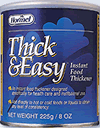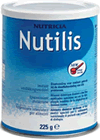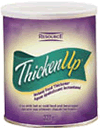“Thickener may be useful in the preparation of texture modified solids, however the evidence for the medical effectiveness of thickening drinks for patients with swallowing problems remains variable.
Thickener in drinks should not be used routinely for people with dysphagia but it may be recommended by Speech and Language Therapists after thorough assessment of all aspects of patient care.”
(NHS Highland Speech and Language Therapy consensus statement regarding Thickener. NHS Highland Speech and Language Therapy Adult Specialist Network (2017)).
There are various commercial thickening powders on the market. The most widely used ones in the UK are:



(Please note: these pictures & details are due to be updated to reflect the most widely used thickening products)
For some patients, the SLT recommendations might be to thicken a patient’s drinks to a level 1,2,3 or 4 consistency as per IDDSI 2019 (See previous page).
All of these products have guidance on the label about how much thickener is required to produce drinks of the consistency recommended by the SLT. Your SLT department will also be able to provide specific information about preparing drinks to the correct consistency.
Some companies also produced ready to drink, single use, pre-thickened drinks which can be prescribed to patients. There are also thickeners available which are drink-specific eg. for tea, coffee etc.
It is important to remember that thickening drinks is not suitable for everyone and should not be considered the only solution if someone is coughing on Level 0 drinks (thin).
There is evidence which indicates that if thickened fluids are aspirated, they are more likely to cause pneumonia than unthickened plain water would. In some health boards there have been consensus statements devised which discusses this further.
For information on how to thicken drinks for patients like Connie select the Additional Information button.
Remember – to monitor the patient’s fluid intake whilst on thickened drinks to make sure they are meeting their requirements.
Page last reviewed: 10 Apr 2021


